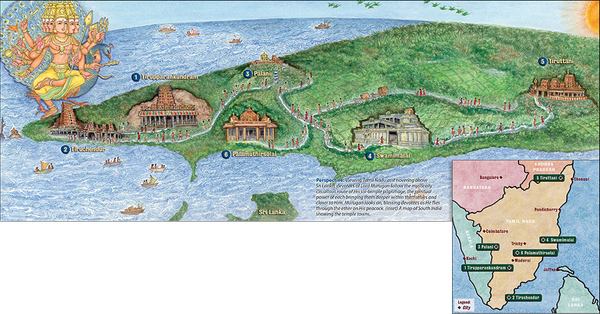
A. MANIVEL§
Perspective: Viewing Tamil Nadu as if hovering above Sri Lanka, devotees of Lord Murugan follow the mystically circuitous route of His six-temple pilgrimage, the spiritual power of each bringing them deeper within themselves and closer to Him. Murugan looks on, blessing devotees as He flies through the ether on His peacock. (inset) A map of South India showing the temple towns
• • • • • • • • • • •§
EDUCATIONAL INSIGHT§
Journey to Murugan
A sacred pilgrimage to the arupadaiveedu, Lord Karttikeya’s six renowned temples in the land of Tamil Saivism§
 HE DEVOTEE WHO SEEKS THE DARSHAN OF LORD MURUGAN, the Tamils’ most beloved God, no doubt finds Him at all of His temples. But those who really want to get Murugan’s attention set out on an unforgettable journey, one both within and without. For those who seek His blessings for the upward climb of kundalini, the arupadaiveedu, meaning “six encampments,” is the pilgrimage of choice. The destinations of this journey are first Tirupparankundram, then Tiruchendur, followed by Palani, Swamimalai, Tiruttani and finally Palamuthirsolai. The fact that this sequence is far from geographically convenient is part of the austerity that comes with any true pilgrimage.§
HE DEVOTEE WHO SEEKS THE DARSHAN OF LORD MURUGAN, the Tamils’ most beloved God, no doubt finds Him at all of His temples. But those who really want to get Murugan’s attention set out on an unforgettable journey, one both within and without. For those who seek His blessings for the upward climb of kundalini, the arupadaiveedu, meaning “six encampments,” is the pilgrimage of choice. The destinations of this journey are first Tirupparankundram, then Tiruchendur, followed by Palani, Swamimalai, Tiruttani and finally Palamuthirsolai. The fact that this sequence is far from geographically convenient is part of the austerity that comes with any true pilgrimage.§
Satguru Sivaya Subramuniyaswami, founder of HINDUISM TODAY, sent a number of his monks on this sacred pilgrimage in the 1970s, 80s and 90s. In December, 2006, his successor, Satguru Bodhinatha Veylanswami, continued the tradition, sending three monks from his Hawaii monastery, including one of the magazine’s editors, to South India for the pilgrimage. This Educational Insight has been developed from their collective experience. It contains spiritual and practical information on the pilgrimage to serve as inspiration for devotees of Lord Murugan to set out upon it and tips for a successful journey.§
Skanda, as Murugan is called in the Vedas, was born of a red spark from Supreme God Siva’s third eye. This Deity of the spiritual path is held in highest regard by the Tamil people, who call Him Murugan, meaning “beautiful.” Thousands of His temples dot the landscape of South India and Sri Lanka—and in modern times, everywhere the Tamil people have migrated, including England, Germany, Fiji, Australia, America, Canada, Malaysia and France. Of all the Murugan temples in Tamil Nadu, the six in this pilgrimage are most revered. They were collectively immortalized by Saint Nakkirar in his second-century song Tirumurugarrupadai, hailed as one of the most important works of Tamil Sangam literature. And they were given special renown in the songs of saints Arunagirinathar, Kumaraguruparar and other luminaries.§
A lyrical narrative, both philosophical and theological, Tirumurugarrupadai was instrumental in propagating Murugan worship in its time. Well known today, it is often sung by devotees as a hymn of protection. Saint Nakkirar enunciates a concept central to the Saiva Siddhanta theology of South India, that in the act of spiritual liberation, God’s initiative is as intense and indispensable as that of the devotee. Nakkirar invokes the grace of Murugan to take the initiative and shower grace upon the seeker who visits His six abodes.§
The significance goes beyond Saint Nakkirar’s having woven the temples into his enchanting poem in specified order. There is metaphysical meaning, too. Yogis of yore determined that each temple stimulates a specific chakra in the subtle body of man: Tirupparankundram lights a fire in the muladhara chakra governing memory at the base of the spine. Tiruchendur moves the next chakra, svadhishthana, below the navel, governing reason. Palani animates the manipura chakra of willpower at the solar plexus. Swamimalai spins the heart chakra, anahata, the center of direct cognition. Tiruttani opens the vishuddha chakra of divine love at the throat, and Palamuthirsolai electrifies the third eye of divine sight, ajna chakra.§
Nowadays, each temple is thronged by thousands, or tens of thousands, of devotees every day, and many more during annual festivals. Multitudes of sincere seekers of every generation since Nakkirar have wended their way through the life-transforming experience of the arupadaiveedu pilgrimage. At the outset of Tirumurugarrupadai, Nakkirar assures us, “With a heart imbued with love and purity, and a will tuned to do His bidding in virtuous acts, if you seek His abodes, then shall be fulfilled all your cherished desires and objects.”§
THE VIDEO PLAY BUTTON ABOVE WILL TAKE YOU TO A WEB PAGE WHERE YOU CAN SEE A VIDEO SLIDESHOW OF 36 ADDITIONAL PHOTOS OF THE SIX TEMPLES. THE AUDIO PLAY BUTTON WILL BRING YOU TO 13 SELECT SONGS BY SAINT ARUNAGIRI NATHAR ABOUT THE SIX TEMPLES§
